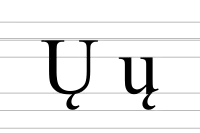| U with ogonek | |
|---|---|
| Ų ų | |
 | |
| Usage | |
| Writing system | Latin script |
| Language of origin | Chipewyan Dadibi Dalecarlian Gwichʼin Hän Iñapari Ixtlán Zapotec Kaska Lithuanian Sierra Otomi Sekani Tagish Tlingit Tutchone Winnebago |
| Unicode codepoint | U+0172, U+0173 |
| History | |
| Development |
|
| Other | |
| Writing direction | Left-to-Right |
U with ogonek (majuscule: Ų, minuscule: ų) is a letter of the Latin alphabet formed by addition of the ogonek to the letter U. It is used in Lithuanian,[1] Chipewyan, Dadibi, Dalecarlian, Gwichʼin, Hän, Iñapari, Kaska, Sierra Otomi, Sekani, Tagish, Tlingit, Tutchone, Winnebago, and Ixtlán Zapotec.
Usage
In Lithuanian, it is the 28th letter of the alphabet, and is pronounced as long close back rounded vowel ([uː]). In the past, the letter was used to denote the nasalized close back rounded vowel ([ũ]). Currently, it appears in the words that used to be nasalized in the past, for example in siųsti, which means send.[1]
The letter also appears in various Indigenous languages of North America, which are: Chipewyan, Dadibi, Dalecarlian, Gwichʼin, Hän, Iñapari, Kaska, Sierra Otomi, Sekani, Tagish, Tlingit, Tutchone, Winnebago, and Ixtlán Zapotec. In most of them, the letter represent the nasalized close back rounded vowel ([ũ]).
Encoding
| Preview | Ų | ų | ||
|---|---|---|---|---|
| Unicode name | LATIN CAPITAL LETTER U WITH OGONEK | LATIN SMALL LETTER U WITH OGONEK | ||
| Encodings | decimal | hex | dec | hex |
| Unicode | 370 | U+0172 | 371 | U+0173 |
| UTF-8 | 197 178 | C5 B2 | 197 179 | C5 B3 |
| Numeric character reference | Ų | Ų | ų | ų |
| Named character reference | Ų | ų | ||